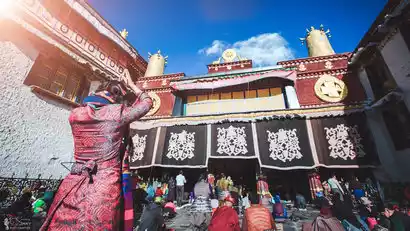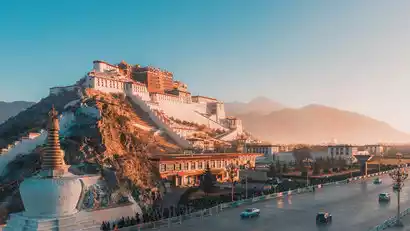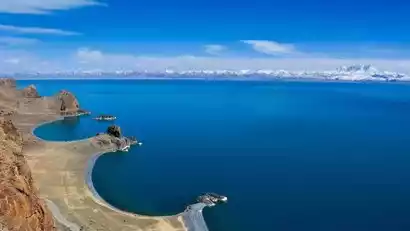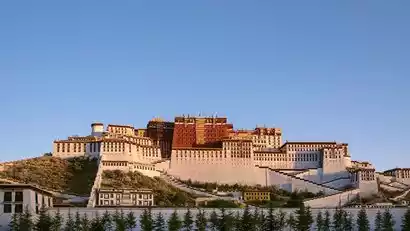Day 1 Various locations - Lijiang★Assembly Day
All day
Today is the meeting time for the event. We offer a 24-hour free airport/station pick-up service, and our driver will take you to your meeting hotel. Those arriving early can stroll through Lijiang Old Town or watch the sunset at Qingxi Reservoir. After dark, the vibrant life of the Old Town is also worth looking forward to.
Kind tips:
The check-in time is after 14:00. Friends who arrive early can check in directly if there are rooms available. If there are no rooms available, you can leave your luggage at the front desk and move around freely.
Please inform the flight number, time and number of passengers 2 days in advance. Failure to inform will be deemed as automatic waiver.


Day 2 Lijiang → Dukezong Ancient Town → Jinsha River First Bend → Feilai Temple (3500m above sea level)
·morning
Dreaming of Shambhala, praying in the ancient city of Dukezong
After breakfast at the hotel, we departed for Shangri-La's Dukezong Ancient Town, a city with over 1,300 years of history. High atop Dukezong, we visited Guishan Park, where you'll find a massive, gilded copper prayer wheel (21 meters tall, weighing 60 tons, and listed in the Guinness Book of World Records). Join us in turning the wheel and chanting prayers.
·afternoon
Heading north along the Jinsha River to the Meili Snow Mountain
We set off for Meili Snow Mountain in due time, passing through Moon Bay, also known as the "First Bend of the Jinsha River." The Jinsha River, flowing through mountains and valleys, makes a graceful "Ω"-shaped bend around the pyramid-like Rizui Peak. We paused briefly to admire the scenery before passing Baima Snow Mountain, where we saw the beauty of our first snow-capped mountain of this trip.
Arriving at Wunongding, this is the place with the widest view in Deqin and the best spot to "view the panoramic view of Meili Snow Mountain".
Go to Feilai Temple and stay at the Viewing Inn. In the evening, you can go to the Mingzhu Laka Viewing Platform to watch the "Meili Snow Mountain Sunset".
Kind tips:
Tonight's accommodation is at an altitude of approximately 3,400 meters;
Today is our first day in the plateau, so showering, washing your hair, and strenuous exercise are not recommended to prevent altitude sickness and give your body some time to adapt.
If you experience symptoms such as headaches, chest tightness, shortness of breath, or drowsiness, these are considered mild altitude sickness and will generally subside after 24 hours of adaptation. If symptoms persist, please contact your driver and customer service representative immediately.
No breakfast is provided at any accommodation in Feilai Temple. Guests can only dine at nearby restaurants. Please understand.


Day 3 Feilai Temple → Yanjing Ancient Salt Fields → Hongla Mountain Pass → Mangkang (4317 meters above sea level)
·morning
Get up early to wait for the sun to shine on the golden mountain, and cross the Yunnan-Tibet border to challenge the Jiajia Noodle record
Rise early and arrive at the Pearl Laka Observation Deck to witness the mystical "Golden Peak of Meili Snow Mountain." The golden light shone upon Mount Kawagebo and Mount Mentsemu, a breathtaking spectacle. Mount Meili is a renowned pilgrimage site in Tibet, nestled between the Nujiang and Lancang Rivers in the Hengduan Mountains. Its main peak, Mount Kawagebo, at 6,740 meters, is considered the "Roof of Yunnan" and is prohibited for climbing due to cultural protection, remaining unconquered.
We then journeyed upstream along the Lancang River valley, crossing the Yunnan-Tibet Boundary Monument. From here, we officially entered Tibet. Arriving in the Tibetan town of Yanjing, we visited the filming location of A Bite of China and sampled the delicious and delightful Yanjing Jiajia Noodles. The restaurant currently boasts a record of 147 bowls, so feel free to challenge yourself.
·afternoon
God's Eyeshadow Palette: Learn about the past and present of the ancient salt fields
Then we will go to the [Millennium Ancient Salt Fields] in Gada and visit the [Yanjing Historical and Cultural Exhibition Hall]. This is the place where my country has preserved the original manual salt-drying method. Along the banks of the Lancang River, large and small ancient salt fields have existed for thousands of years.
We then crossed the Hongla Mountain National Nature Reserve and arrived at Mangkang County to check in. (Today is the first day in Tibet. To allow your body to better adapt, try to rest early.)
Kind tips
Today's itinerary is relatively easy, so everyone should rest early to allow the body to better adapt to the high altitude and prepare for the rest.
You can shower and wash your hair today, but please be sure to shorten your shower time and keep the bathroom well ventilated. If you feel unwell, please contact your driver or customer service manager immediately.
Mobile phone signals are very poor at the Yunnan-Tibet border, so please be sure to handle any matters in advance;
There is only one restaurant in the county town for lunch tomorrow, and the variety of restaurants is very limited. If you don't like it, you can buy some dry food in Mangkang today.


Day 4: Mangkang → Zhiri Mountain Pass → Jampa Ling Monastery → Qamdo (3240m above sea level)
·morning
Cross the pass and enjoy the beautiful scenery along the way
Have breakfast at the hotel, take a short rest to adjust to the plateau environment and set off at the right time.
Heading north, we arrived at the Zhiri Mountain Pass (4,800 meters above sea level), which is the first high-altitude pass on the journey. The real sparsely populated and beautiful scenery begins from crossing this pass.
Arriving at Chaya County on the way, we will have lunch here.
·afternoon
Go upstream and pay homage to the "First Zen Temple in Eastern Tibet"
After lunch, we will set off in time and head north along the Lancang River, enjoying the endless beautiful alpine meadows and forest scenery along the way.
Arriving in Qamdo, we will head to Jampa Ling Monastery, the largest Tibetan Buddhist temple in eastern Tibet. The temple is filled with pious beliefs and rich cultural themes. The red soil, red walls, and red-robed monks make it a spectacular sight to see countless monks sitting in the empty Buddhist halls within the high-walled courtyards.
We will stay in Qamdo tonight, which is the largest city in eastern Tibet and the third largest city in Tibet. We will check in early today and have a good rest to conserve our energy for the upcoming highlights: snow-capped mountains, holy lakes, glaciers, and off-road feasts.
Kind tips:
1. When visiting Jampa Ling Monastery, please be sure to respect the customs of the monastery and do not offend the monks.
2. There is no fixed restaurant available for lunch tomorrow. There are very few towns along the way. Qamdo is the largest city in eastern Tibet. It is recommended to go to the supermarket to buy the next two meals as a backup.
3. Today's journey is arranged to be relaxed and comfortable, so that your body can adapt to the plateau as quickly as possible. Tomorrow will be a visual feast for our itinerary, so please try to rest early. If you feel unwell, please contact the driver leader or customer service butler in time.


Day 5: Qamdo → Zizhu Monastery (4800m above sea level) → Dingqing
·morning
The historical accumulation of hundreds of stone pagodas and the spiritual inheritance of Mani stone carvings
After breakfast, we will depart for Kamado Pagoda Forest Monastery, an ancient building built more than 800 years ago. It has stood tall despite the baptism of time and has maintained the square shape of the early pagoda. In Tibetan, it is interpreted as a tower like a house.
·afternoon
Visit the clifftop temples and learn about the continuation of Zhangzhung civilization
In the afternoon, we'll travel through the Red Canyon area before reaching Tsezhu Monastery (4,800 meters above sea level). If you haven't visited Tsezhu Mountain, you wouldn't know that perched atop the cliffs is one of Tibet's highest Bon monasteries, also known as the "Sky City." Today, we'll have plenty of time to fully explore Tsezhu Monastery. We'll spend the day at Tsezhu Monastery's "Salongda" (Salungda). Afterward, we'll transfer to Dingqing for overnight stay.
Note: The road leading to Zizhu Monastery is under construction from April 7th to August 15th. The road will be open to traffic at irregular intervals. If the road is closed, the afternoon itinerary will be changed to a visit to Butuo Lake.
【Dinner】Please arrange it yourself;
Kind tips:
There will be no restaurants at the scenic spots tomorrow, so you will need to prepare your own food. If you did not buy food in Qamdo yesterday, please go to the supermarket to buy some dry food today.
Today we have already entered the heart of eastern Tibet. The accommodation and dining conditions are incomparable to those in big cities. Please keep a normal mind.
The altitude of Zizhu Temple is about 4,500 meters. Please slow down as much as possible when walking. We have plenty of time, so you can walk and take photos slowly.
When traveling in Tibetan areas, please be sure to observe local customs and habits and do not offend them. If there are any issues that cannot be resolved through communication, please contact the driver or tour leader promptly.
Normally, most people have fully adapted to the plateau by today's date, but if you still experience any discomfort, please contact the driver or customer service manager in a timely manner.


Day 6 Dingqing → Buga Snow Mountain → Zuxhexue Glacier → Kangqingla Mountain Pass (5360m) → Bilu (Today's entire journey is above 4000m)
·morning
Travel through the sacred mountains of eastern Tibet and experience the wonders of the lesser-known glaciers
After breakfast at the hotel, we set off to Buga Kangri, also known as Buga Snow Mountain. This is also the highest snow mountain in eastern Tibet. The main peak is 6,328 meters above sea level, making it the highest peak in eastern Tibet and one of the Seven Sacred Mountains in Tibet.
Tibetans who practice Bon Buddhism circumambulate the mountain annually, prostrating themselves, a process that typically takes five to seven days. In their veneration of the sacred mountain, locals consider the wildlife, every blade of grass, every tree, every grain of sand, every stone, as an integral part of the sacred mountain. Here, all things are mortal, only faith is eternal. This sacred land of eastern Tibet is sure to captivate you.
Then we started to explore a cross-country route we had discovered, crossing from the north slope of Buga Snow Mountain to the Zuxhe Glacier on the south slope. The scenery along the way was breathtaking, a view that would amaze every traveler who followed us here.
Arriving at the largest valley on the south slope, you will see the glacier. The glacier has a wide snow basin and a large accumulation area. Its ice tongue is narrow and long, with the end at an altitude of 4,200 meters. There are moraine ridges from the Little Ice Age around the front end of the ice tongue. You can follow the plank road directly to the front of the glacier's ice lake and face the glacier directly, which is very shocking.
·afternoon
Crossing the "Little Duku" in Tibet, the worse the road, the more beautiful the scenery
Depart at an opportune time in the afternoon, taking a scenic route rarely traveled, even by seasoned Tibetan hikers. Along the way, we'll cross the Kangqingla Mountain Pass (5,360 meters above sea level). In summer, wildflowers blanket the slopes, while in autumn, the summits offer endless views of snow-capped mountains. The winding mountain road, interspersed with meadows and snow-capped mountains, has earned the nickname "Little Duku Highway" in Tibet. We'll prepare longda and prayer flags for you, offering you the traditional Tibetan way of praying for your family.
Overnight in Biru County.
Tips:
1. Today's accommodation is approximately 3,900 meters above sea level.
2. Today's journey will be long, with breathtaking scenery along the way. You may arrive at your hotel around 8:00 PM, so please be prepared and maintain a calm demeanor.
3. All of today's scenic views are located at altitudes above 4,000 meters. Please slow down, avoid running or jumping, and stay warm to avoid catching a cold.
4. There will be no dining options today, so please be sure to prepare dry food and roadside snacks in advance.
5. The off-road route is pristine and unpaved, so the road conditions will be inversely proportional to the scenery. Please be prepared.


Day 7: Biru → Xala Pass → Sapu Sacred Mountain (4800m above sea level) → Samtso → Biru
All day
Enter the sacred mountain of Sap and spend a day gazing at the snow-capped mountains
After breakfast at the hotel, we'll depart to explore Sapu Sacred Mountain (4,800 meters), which became a sensation overnight in 2017. Along the way, we'll ascend the 5,072-meter Xiala Mountain Pass, the highest snow-capped mountain pass along the central route of eastern Tibet. This is the only way to reach Sapu Sacred Mountain. While the road is rugged and bumpy, its breathtaking scenery only scratches the surface of Burang County, the picturesque "Little Jiangnan of Northern Tibet." The true wonder of Sapu Sacred Mountain lies just ahead. Upon arrival at Sapu Sacred Mountain, known as "Sepu Gangri" in Tibetan, its main peak rises to 6,956 meters. Surrounded by numerous uniquely shaped peaks and breathtaking glacial lakes, it forms a sacred mountain and lake community, rich in cultural heritage and breathtakingly beautiful. We'll first arrive at Samtso Lake, where we'll enjoy panoramic views of the sacred mountain from afar. We'll also provide afternoon tea on the drive. Enjoy a cup of coffee or tea by the lake, with the SUV at your side, and gaze quietly at the snow-capped mountains and glaciers before you. This moment is a poetic and distant place, and Sapu is yours alone. We'll leave plenty of time to fully appreciate the beauty of Sapu. After a satisfying visit, we'll depart Sapu and return to our hotel.
Warm reminder:
Currently, only the outer lake of Sap is open. Vehicles are not allowed to enter the inner lake for the time being. Please understand that if the inner lake is opened later, we will arrange entry;
It is not recommended to hike into the inner lake. It takes 8-10 hours to go back and forth, and the altitude is 4,800 meters, which is a great test of physical strength. You can climb a little to the road halfway up the mountain to take pictures of the whole view.
The average altitude of Sap is 4,800 meters. Remember to move slowly and avoid running or jumping.
Today we have prepared camping equipment, kettle, tea, coffee, etc. for everyone on our off-road vehicle. Friends who are interested can come and experience it;
It is not convenient to have lunch in Sapne today, so it is recommended to prepare dry food or meals on the road in advance.


Day 8: Biru → Damu Temple → First Bend of Nujiang River → Nagqu Grassland → Phuntsok → Bamtsok → Bange
·morning
Visit a mysterious temple and head west along National Highway 317
After breakfast at the hotel, we'll depart and arrive at the First Bend of the Nu River, marking the first major bend in the river's upper reaches. We'll then visit the mysterious Damu Monastery, home to a rare temple in Tibet known as the Wall of Skulls, where skulls are preserved after sky burials. We encourage you to maintain respect during this hidden sacred site, refrain from making loud noises, and seek permission from the temple management before taking photos. We'll continue along the grassland highway, passing the Nagqu Grassland, arriving in Nagqu City. Nagqu, also known as the Black River, is the source of major rivers like the Yangtze, Nu, and Lancang, earning it the reputation of "the source of rivers" and "the water tower of China." We'll enjoy lunch here.
·afternoon
Stare at the two hidden lakes and enjoy the beautiful scenery
This afternoon, we'll visit two unassuming lakes, Phuntsok and Bamtsok. Though relatively unknown, they're essential stops on the journey from Nagqu to Bange. Phuntsok, meaning auspicious and complete in Tibetan, boasts crystal-clear waters whose color changes with the weather: sapphire blue on sunny days and a deep dark green on cloudy ones. Bamtsok, known as Namtsok's "sister lake," isn't as famous, but equally beautiful. It offers a sense of tranquil beauty, yet also a sense of desolation.
Overnight in Bangor County.


Day 9 Bange → Namtso Lake → Holy Elephant Gate → Lhasa
·morning
Accept the blessing of the plateau holy lake and get close to the long-lost Holy Elephant Heaven Gate
Today we are heading to the long-awaited Namtso Lake and Holy Elephant Gate. We will drive along the lake for a short drive and enter the Holy Elephant Gate Scenic Area. We will press the shutter to take photos of our lives. Wearing brightly colored clothes will make the photos more effective.
[Namtso] (Altitude: 4770 meters) Tianhu, one of the three sacred lakes in Tibet, covers an area of about 1920 square kilometers. Looking at the lakeside from afar, the water and sky are one color, the blue sky and blue lake are integrated into one. The islands in Namtso Lake are dotted with various shapes!
·afternoon
Take one last look at you and wave goodbye
We set off at the right time, crossed the Nagenla Pass of the Nyainqentanglha Mountains, took a last look back at Namtso Lake, and then returned to Lhasa to end this trip.
Upon arrival in Lhasa, the tour will be dispersed at a designated location (within 3 kilometers of the Potala Palace, and we will transfer you directly to your designated hotel). If you have time, you can explore Barkhor Street and bring back gifts for friends and family. However, bargaining is crucial, and it's all about discernment. Our advice: enjoy small purchases, but exercise caution with valuables.
Kind tips:
If you are planning a return trip from Lhasa Railway Station, it is recommended to book a high-speed train or train after 20:30 on the same day;
If you are planning a return flight from Lhasa Airport, it is recommended to book a flight that departs after 23:30 on the same day.
If you are not leaving on the same day, you can also contact customer service to book a hotel in Lhasa.









